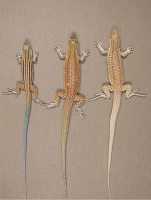The origin of Marmorkrebs is still unknown. Hybridization of two species in aquaria has sometimes been tossed around as a potential hypothesis. It has some plausibility, given that almost every parthenogenetic vertebrate seems to trace back to a hybridization event. A new paper would seem to make the hybridization hypothesis slightly more plausible.
I’ve written before about whiptail lizards, the first multicellular animals I learned of that reproduced by parthenogenesis.
A paper in press by Aracely and colleagues describes the latest research on these animals: make a new, self-sustaining, hybrid from scratch. And the experiment was a success! The picture shows the hybrid in the middle of the two parental species. The hybrids have been reared through multiple generations in the lab, so this is not just a one-off event.
I can’t provide better coverage than Ed Yong does at Not Exactly Rocket Science. More coverage at Ars Technica.
The most remarkable thing about the publication of this success is that it comes only a year after another paper described a 29 nine year effort to do exactly this (Cole et al. 2010), without success.
Knowing that something is possible and has happened in nature doesn’t mean that it is likely to happen in the lab while we’re looking.
Reference
Lutes AA, Baumann BP, Neaves WB, Baumann P. 2011. Laboratory synthesis of an independently reproducing vertebrate species. Proceedings of the National Academy of Sciences 108(24): 9910-9915. http://dx.doi.org/10.1073/pnas.1102811108
Cole CJ, Hardy LM, Dessauer HC, Taylor HL, Townsend CR. 2010. Laboratory hybridization among North American whiptail lizards, including Aspidoscelis inornata arizonae × A. tigris marmorata (Squamata: Teiidae), ancestors of unisexual clones in nature. American Museum Novitates 3698: 1-43. http://hdl.handle.net/2246/6085
10 May 2011
Subscribe to:
Post Comments (Atom)







No comments:
Post a Comment